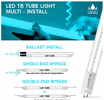After almost exactly 50 years, the ballasts in my basement ceiling lights are beginning to fail. It looks like I've put off converting them to 4-foot LED tube lights as long as I can.
Very few available options will drop in and work with *old* magnetic ballasts with zero wiring mods. Rewiring the fixtures is simple, there is lots of room, and I've got all the toys. The question is about the feed.
There are two options for ballast bypass, single-end and double-end. I've fought my way through phone systems for both manufacturers and vendors, and ***nobody*** will take a stand on which is better. "Better" could mean more reliable, or a higher probability of turning out to be the preferred method, and more availablre in the future. It feels like a return to the VHS-vs-Beta days, except back then everyone had a strong opinion, and today no one does.
So, any y'all got experience, war stories, whatever on this topic. I'm rewiring around 40 tubes, and don't want to do it twice. Which feed method is least likely to bite me 10 years down the road?
Thanks.
ak
Very few available options will drop in and work with *old* magnetic ballasts with zero wiring mods. Rewiring the fixtures is simple, there is lots of room, and I've got all the toys. The question is about the feed.
There are two options for ballast bypass, single-end and double-end. I've fought my way through phone systems for both manufacturers and vendors, and ***nobody*** will take a stand on which is better. "Better" could mean more reliable, or a higher probability of turning out to be the preferred method, and more availablre in the future. It feels like a return to the VHS-vs-Beta days, except back then everyone had a strong opinion, and today no one does.
So, any y'all got experience, war stories, whatever on this topic. I'm rewiring around 40 tubes, and don't want to do it twice. Which feed method is least likely to bite me 10 years down the road?
Thanks.
ak


